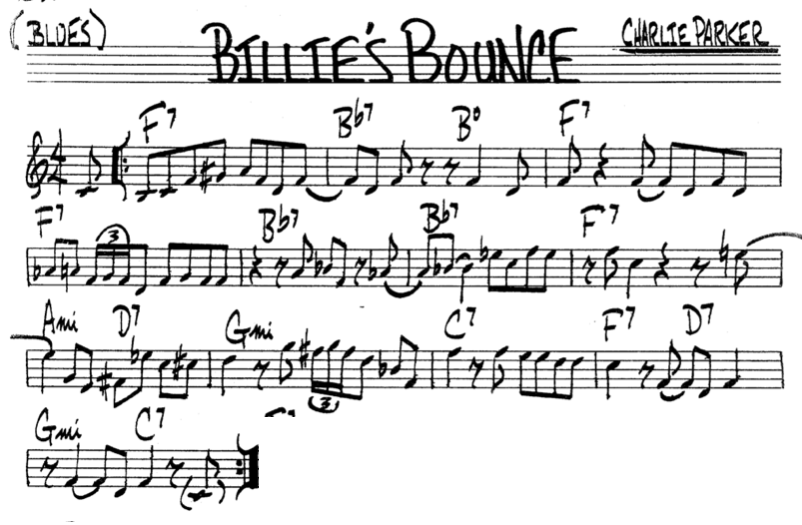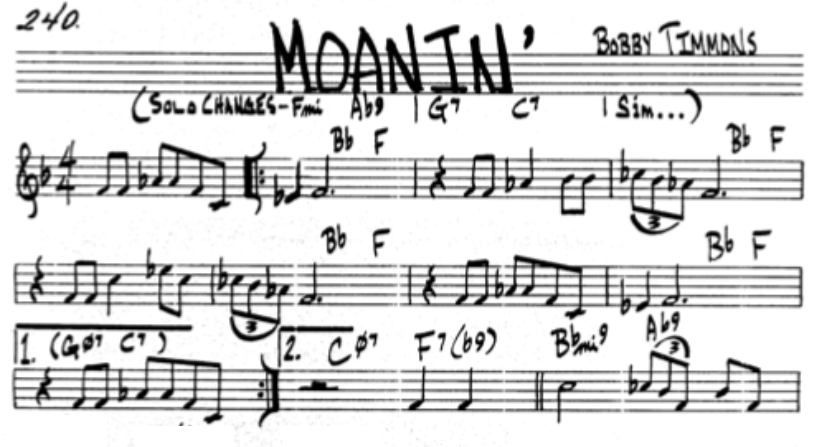Hard Bop Characteristics
Hard bop was the dominant genre as Jazz from about 1955 to 1965. It’s characterised by:
- A strong blues and gospel influence (Return to Roots). So use of:
- Blues scale
- Dominant chords
- Blue notes & bent notes
- Repetition
- Call and response
- Suspend chords and pedal point
- It generally used minor keys/modes
- It was more emotive, raw, hot
- A strong driving rhythm, with a heavy backbeat (so accent on beats 2 & 4), which set up a solid rhythmic groove
- Because of these rhythmic features, Hard bop was actually the last genre of Jazz that people danced to
- Slow & medium tempos
- Simpler, lyrical and more memorable melodies
- Because of this Jazz became ‘popular’ again, just like Swing Music, as it was more accessible to the general public than Bebop
- 12 bar and 32 bar forms using a Head-Solo-Head structure
- But whereas in Bebop the melody of the Head was generally played in unison by trumpet and sax
- In Hard bop, the melody in the Head was generally harmonised
- A small ensemble, generally a rhythm section and two or three horns
It arose due to some combination of the following reasons:
- As a reaction to Cool Jazz
- As a result of the rise of Rhythm n’ Blues in the late 1940’s and early 1950’s
- To return Bebop to melody
Reaction to Cool Jazz
I have a separate lesson on Cool Jazz which discusses this genre in detail. But in short, throughout most of Jazz History there have been two countervailing forces pulling on it.
- On the one hand, Jazz was pulled towards a more Classical tradition;
- And on the other hand, Jazz was pulled towards a more Blues tradition
Well, Cool Jazz was the former. It was heavily influenced by the European Classical Music tradition. It was more restrained (and less emotional), it relied more on composition (than improvisation), and it was softer and more polite. In a word, it was played ‘cool’.
So Hard bop was partly a reaction to this trend towards the Classical influenced Cool Jazz, and decidedly tried to pull Jazz back towards its roots – back towards Blues. So rather than being ‘Cool’, Hard bop is ‘Hot’.
Rise of Rhythm & Blues
As well as a reaction to Cool Jazz, Hard bop was also heavily influenced by the rise of Rhythm and Blues and Black Popular Music in the late 1940’s and early 1950’s. Now, the Blues had been around for decades, of course, but it was only in the 1940’s & 1950’s, when it was electrified and amplified, did it become hugely popular. So there was the rise of:
- Gospel – Mahalia Jackson
- Chicago Blues – Muddy Waters & Howlin’ Wolf
- Soul (which is just secularised gospel) – Ray Charles
- Rock n Roll – Chuck Berry
- RnB – Fats Domino & Professor Longhair
So it was only natural that Jazz musicians were influenced by this blossoming in ‘Blues and Roots’ music. And so Hard bop took on a lot of this ‘Rhythm and Blues’ feel, and indeed many Jazz musicians also played in RnB groups.
To Return Bebop to Melody
Before bebop there was Swing, which was melodic, danceable, and popular music. Bebop turned Jazz into art music – with angular and difficult melodies, fast tempos, complex harmonies and fast chord changes. Bebop was complex and un-danceable, and therefore unpopular.
So, Hard-bop moved back in the other direction. It used simpler melodies that were easier to sing, a slower tempo, a strong backbeat, a solid bluesy groove, all of which made it very danceable and thus popularised Jazz again. But it still retained Bebop’s vertical or harmony based improvisation.
Bebop Melody

This is Billie’s Bounce, a Bebop 12 Bar Blues. As you can see, despite being a Blues, the melody isn’t very Bluesy. Rather, it is quite angular and complex.
Hard Bop Melody

This is Moanin’, a Hard Bop Jazz Standard. Notice how much simpler and Bluesier the melody is. In fact, the melody only uses the F Blues scale.
Hard Bop
Like so many genres of Jazz, Miles Davis was partially responsible for creating Hard bop with his 1954 recordings – Walkin’ and Blue & Boogie. But the quintessential Hard bop band was really The Jazz Messengers.
- When Horace Silver was leading the band, they had a hit with:
- The Preacher ~ Horace Silver
- This song is Gospel influecned and sound very ‘old timey’. In fact, it was almost not released because it was considered too anachronistic.
- The Preacher ~ Horace Silver
- And when Art Blakey was leading the band, they had a hit with:
- Moanin’ ~ Bobby Timmons
- This song is Blues influenced. It has a simple bluesy melody, uses call and response, and a IV-I Plagal (church-like) cadence.
- Moanin’ ~ Bobby Timmons
Soul Jazz
Some people further divided Hard bop into a subgenre called Soul Jazz – which, as the name implied, was influenced by soul music. It is characterised by:
- Almost always using the Hammond Organ
- Gospel/Soul inspired
- Compared to Bebop, it was harmonically very simple – it generally only used 2 or 3 chords vamps for the entire song and often just used triads rather than extended or altered chords
- And each song is generally highly repetitive and very long
LP
Hard bop and Soul Jazz recordings are often quite long. This is because the LP vinyl record was introduced in 1948.
- Pre-1948 – records rotated at 78 rpm so songs could only last 3-4 minutes before the record was used up
- Post-1948 – LP records rotated at 33 1/3 rpm so songs could now last for up to 20 minutes
This is why Bebop and Swing recordings are so short. Jazz took advantage of this advance in technology and produced long songs with extended improvisations. Longer songs meant fewer songs per album, which also meant fewer royalties needed to be paid to composers
Have a Listen to:
- Hard Bop
- Miles Davis (Walkin’; Bags’ Groove)
- Horace Silver & The Jazz Messengers
- Art Blakey & The Jazz Messengers
- The Three Sounds
- John Coltrane (Blue Train)
- Cannonball Adderly
- Lee Morgan
- Clifford Brown
- Sonny Rollins
- Soul Jazz
- Jimmy Smith
- Richard ‘Groove’ Holmes
- Jimmy McGriff
- Johnny ‘Hammond’ Smith
- Brother Jack McDuff
- Grant Green
- Wes Montgomery
- Ramsey Lewis
- Ray Bryant